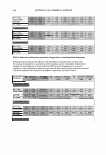J. Cosmet. Sci., 55, 343-350 CTuly/August 2004) Quantitative determination of formaldehyde in cosmetics using combined headspace-solid-phase microextraction gas chromatography RENE THOMAS RIVERO and VINOD TOPIW ALA, Coty Research and Development Center, 410 American Road, Morris Plains, NJ 07950-2451. Accepted for publication May 21, 2004. Synopsis The objective of this research was the application of headspace (HS)-solid-phase microextraction (SPME) for the quantitation of formaldehyde present in raw materials and cosmetic formulations. The formaldehyde was derivatized in situ first with pentafluorophenylhydrazine (PFPH), to form a derivative hydrazone. The formed hydrozone was adsorbed on a SPME fiber during headspace extraction under controlled conditions (time, temperature, volume, etc.). After the adsorption step, the SPME fiber was directly transferred into the gas chromatography (GC) injection port in which the analytes were thermally desorbed. Deuterated acetone was used as an internal standard (IS) in order to quantitate the formaldehyde content. For the experiment, a gas chromatograph equipped with a flame ionization detector (GC/FID) was employed. A gas chromato graph/mass spectrometer (GC/MS) was used for the qualitative confirmation of results in this work. INTRODUCTION For decades, formaldehyde was one of the most widely used preservatives in personal care products due to its versatility, cost, and efficiency. In recent years, the potential for carcinogenic and respiratory sensitization from formaldehyde has become widely under stood. This has led to a movement in the industry that has imposed regulations, restrictions, and formaldehyde's usage being banned. In surfactant and cosmetic industries several analytical procedures have been developed for qualitative as well as quantitative analysis. One of the most well known procedures for qualitative analysis is the phloroglucinol test, in which formaldehyde reacts in an alkaline medium with phloroglucinol to produce a reddish-brown color complex. For the quantitation of formaldehyde, several methods have been employed, one of which is based on Nash reagent. In this determination, formaldehyde is condensed with ammonia and acetylacetone to form the lutidine derivative 3,5-diacetyl-1,4-dihydrolutidine (1,2). Nash reagent is sensitive not only to formaldehyde, but also to other aldehydes. If chromophore compounds are present in the product, they could interfere with the spectrophotometric determination. Formaldehyde can also be determined colorimetri- 343
344 JOURNAL OF COSMETIC SCIENCE cally with chromotropic acid (3,4). The chromotropic acid test is based on the reaction of formaldehyde with a solution of chromotropic acid (1,8-dihydroxynaphthalene-3, 6-di sulfonic acid) to produce a purple species in solution. The mechanism of this reaction has not been fully elucidated (5). One difficulty with this technique is that some perfume ingredients used in cosmetics liberate aldehydes in an acid medium and give a false positive test. Other techniques have been reported for the determination of carbonyl compound by derivatization with 2,4-dinitrophenylhydrazine (DNPH) utilizing gas chromatography (6). In another technique, high-performance liquid chromatography (HPLC) has been used, after the derivation of formaldehyde by DNPH. This technique has been reported by Wu et al. (7). The Conway microdiffusion technique has been employed for the determination of free formaldehyde (8). This method is based on the principle of gas diffusion from a relatively large volume of solution under analysis to a very small volume of aqueous trapping solution until the free formaldehyde concentration of the test solution is same as in the absorbent solution. The contribution of the present work is attributed to the application of the solid-phase microextraction (SPME) procedure for the determination of formaldehyde in cosmetic products. SPME is a powerful alternative to traditional techniques for the extraction of volatile or semivolatile organic compounds. The method, invented in the early nineteen nineties by Prof. Janusz Pawliszyn (9) from the University of Waterloo in Ontario, utilizes a small segment of fused silica fiber coated with an appropriate material and mounted on a syringe-like device for extraction of analytes from various matrices and introduced to a chromatographic system. No solvents are used in the process. Analyte extraction and pre-concentration are combined in a single step. The technique itself has been thoroughly described (10-12) for qualitative analysis as well as for quantitative determination ( 13-15). EXPERIMENT AL REAGENTS AND MATERIALS The reagents and materials used were water (HPLC grade, J. T. Baker Inc, Phillipsburg, NJ) 37% formaldehyde solution (Sigma, St. Louis, MO) 97% pentafluorophenylhy drazine (Aldrich, St. Louis, MO) sodium chloride (Extra Pure, EM Industries, Dam stadt, Germany) deuterated acetone (Aldrich, Milwaukee, WI) formaldehyde-free so dium lauryl sulfate (Sulfochem SLS-BZ, Chemron, Paso Robles, CA) and formaldehyde free sodium laureth sulfate (Sulfochem ES-2DX-BZ, Chemron). INSTRUMENTS AND EQUIPMENT The instruments and equipment used were SPME fiber, polydimethylsiloxane/ divinylbenzene (PDMS/DVB), 65 µm, catalog no. 57326-U (Supelco, Bellefonte, PA) a headspace vial, 10 ml (Supelco) a block heater (Alltech Associates Inc, Deerfield, IL) a gas chromatograph (HP 6890) equipped with FID (Agilent Technologies, Wilming ton, DE) a mass spectrometer (HP-5973, Agilent) SPME septa (Pre-drilled septa,
Purchased for the exclusive use of nofirst nolast (unknown) From: SCC Media Library & Resource Center (library.scconline.org)






































































































